| Deciduous | |
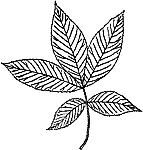 |
 |
| Coniferous | |
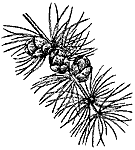 |
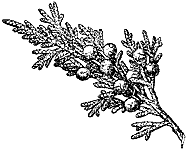 |
Trees contribute much to the quality of life enjoyed in Minnesota, so we naturally are interested in knowing more about them. This book introduces you to more than 100 trees found in Minnesota forests and backyards.
The book is divided into four sections: (1) background information, (2) descriptions of coniferous trees and their identifying characteristics, (3) descriptions of deciduous trees and their identifying characteristics, and (4) projects to help you enjoy learning about trees.
With this book in hand, you'll make many new friends—the trees growing in Minnesota. With pride, you'll be able to say, "That's a sugar maple, and the tree to the left is a basswood."
For our purposes, a tree is defined as a woody plant usually having a single, upright stem growing to a height of at least 15 feet with a defined crown developing at least two or more feet above the ground. Shrubs, in contrast, usually have several upright or spreading stems branching from the base and grow less than 15 feet tall. Plants that commonly develop into trees are included in this book.
When we try to identify things, whether rocks, animals, or trees, we begin by connecting them with groups of things with similar characteristics. Trees can be classified into two broad groups: coniferous and deciduous. Coniferous trees bear their seeds in cones and have very narrow or overlapping leaves. All of our coniferous trees except the larches are evergreens, meaning that they maintain their leaves throughout the year. Deciduous trees, in contrast, do not bear their seeds in cones and have broad leaves that drop in autumn. Figure 1 shows the basic differences between coniferous trees and deciduous trees.
If you know whether a tree is coniferous or deciduous, you are ready to begin. If the tree is coniferous, turn to Section Two. If it is deciduous (or without leaves), turn to Section Three.
The introductions to both sections describe features commonly used to identify trees in each group. They also contain keys for identifying trees by genus (e.g., maple, pine). If you are unsure about how to use an identification key, read "How to Use a Key" below.
Figure 1. Trees can be divided into two groups: deciduous and coniferous.
| Deciduous | |
 |
 |
| Coniferous | |
 |
 |
A key is a tool that reduces the process of identifying something to a series of steps.
If you are trying to identify a tree and think you know its name or genus (e.g., maple, pine), find that tree's description using the species index at the back of this book, then check its characteristics with those provided in the text. To assist your identification, species with similar characteristics are grouped together in the text. If you are unsure of what it is, use the keys to help narrow the possibilities.
Three keys are provided: (1) coniferous trees (page 8); (2) deciduous trees with leaves (page 25); and (3) trees without leaves, including larches (page 75). The keys are based on differences in leaves, twigs, fruits, and bark.
Each step in the key has two alternative descriptions (labeled a and b) with the same number and indentation on the page. Select the one of the pair that best describes the tree you are examining. Proceed to the next pair of descriptions directly below and indented closest to your choice. Continue this process until you get to the name of the genus or species. (If both choices seem reasonable at any step, try going both ways.) Finally, read the species descriptions to confirm your identification.
For example, suppose that the unknown tree you are examining is an imaginary coniferous tree known as blue pine. It has 6- to 8-inch long, bluish-green, needlelike leaves, and 8- to 12-inch long seed cones. The correct steps for identifying the tree are highlighted in the example key below.
Example Key(correct steps for identifying blue pine are highlighted)
|
| SUGAR MAPLE or hard maple (Acer
saccharum) Large tree, 40' - 70' (80') tall; broad, round or oval crown; trunk up to 36" diameter. Leaves: Opposite, simple, 3½" - 5½" long, nearly as wide, palmately lobed; lobes: 5 (rarely 3), rounded crotches, smooth or wavy margins; light green; yellow, orange, or deep red in autumn. Twigs: Reddish-brown to gray with scattered whitish dots (lenticels); buds, reddish-brown to dark brown, cone-shaped, pointed tip, numerous scales. Fruit: Samara, ¾"- 1¼" long, U-shaped pairs with nearly parallel wings, mature in autumn. Bark: Light gray, smooth or warty; becoming dark gray to nearly black with deep, irregular furrows and narrow plates that curl at the edges, sometimes scaly. Range Native, eastern Minnesota; hardy to Zone 3b. Remarks: Very shade-tolerant; slow-growing; long-lived. Attractive, widely planted ornamental tree naturally found on moist, fertile soils. Primary source of maple syrup and maple sugar. Principal timber species; its hard, closely grained, light brown wood is used in furniture, flooring, cabinets, cutting boards, veneer, and musical instruments. Occasionally develops unique wood grain pattern known as bird's eye, curly, tiger, or blister maple. |
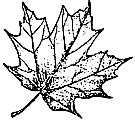  Sugar Maple |
| BLACK MAPLE (Acer
nigrum) Large tree, nearly identical to sugar maple. Leaves: 3-lobed (rarely 5), smooth or wavy margins, abruptly pointed lobes, drooping sides, dark green. Range: Native, southeastern and south-central Minnesota; hardy to Zone 4a. |
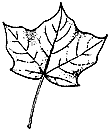 Black Maple |
| RED MAPLE or soft maple (Acer
rubrum) Medium to large tree, 40'- 70' tall; dense, rounded crown; trunk up to 24" diameter. Leaves: Opposite, simple, 2½" - 4" long, nearly as wide, palmately lobed; lobes, 3 or 5 (usually 3), relatively shallow crotches (often pointed); doubly toothed margins; light green; scarlet red, orange, or yellow in autumn; red leafstalk. Twigs: Bright red to reddish-brown with white dots (lenticels); buds, green or dark red, blunt. Fruit: Samara, ½" - 1" long, U-shaped pairs with slightly divergent wings, mature in spring. Bark: Silvery gray, smooth, scaly limb scars; breaking up into large, vertical strips with scaly ridges. Range: Native and hardy throughout Minnesota except along western and southern border. Remarks: Intermediate in shade-tolerance; moderately fast-growing; moderately long-lived. Attractive, hardy tree found on a broad range of site conditions. Tannins boiled from the bark formerly used to produce inks and cinnamon-colored dyes. Important ornamental species that also is sometimes used for maple syrup. Common name, red maple, is based on the color of the tree's flowers, not on its leaves. |
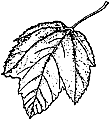  Red Maple |
| SILVER MAPLE or soft maple
(Acer saccharinum) Large tree, 40' - 70' tall; massive, round-topped crown; trunk, often divided low, up to 42" diameter. Leaves: Opposite, simple, 4" - 6" long, nearly as wide, palmately lobed; lobes, 5, 2 deeply cut crotches come to sharp point, doubly toothed margins; dull green (white or silvery below); pale yellow to orange in autumn. Twigs: Yellowish-gray to reddish-brown, disagreeable odor when broken; buds, dark red, blunt. Fruit: Samara, 1½" - 2½" long, V-shaped pairs with widely divergent wings, mature in spring. Bark: Gray; smooth; becoming furrowed with long, scaly, narrow strips that often curl at the ends. Range: Native, southern and east-central Minnesota, north to Duluth and west to upper Mississippi River; hardy to Zone 3b. Remarks: Moderately shade-intolerant; fast-growing; moderately short-lived. Prolific seed producer commonly found in moist bottomland forests. Sprouts vigorously when injured. Extensively planted as a fast-growing street tree that is somewhat tolerant of extreme site conditions, but has brittle branches and roots that may damage sidewalks, sewers, and drains. Occasionally used for maple syrup. |
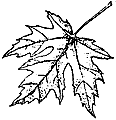  Silver Maple |
| MOUNTAIN MAPLE (Acer
spicatum) Shrub or small tree, 10' - 20' (30') tall; small, irregular crown of upright branches; trunk, often crooked and divided, up to 7" diameter. Leaves: Opposite, simple, 2½" - 4½" long, two-thirds as wide, palmately lobed; lobes, 3 (rarely 5), shallow crotches, coarsely toothed margins; light green; deep red or orange in autumn. Twigs: Yellowish-green to reddish-green with velvety, gray hairs; terminal buds, red, perched on a small stalk, 2 scales. Fruit: Samara, ¾" - 1" long, U-shaped pairs with divergent wings, mature in autumn. Bark: Reddish-brown to brown, thin, smooth or slightly furrowed. Range: Native, northeastern and east-central Minnesota; hardy throughout. Remarks: Shade-tolerant; slow-growing; short-lived. Understory species found in moist, cool, often rocky forests. Live lower branches sprout roots and form new trees when covered by soil or plant litter. |
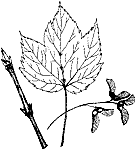 Mountain Maple |
| NORWAY MAPLE (Acer
platanoides) Medium tree, 40' - 60' tall; dense, round crown; trunk up to 24" diameter. Leaves: Opposite, simple, 4½" - 7" wide, nearly as long, exudes milky sap when cut, palmately lobed; lobes, 5, shallow crotches, sharp wavy-toothed margins; shiny green; bright yellow or orange-brown in autumn. Twigs: Greenish-brown to brown; buds, yellowish-green to brownish-red, exude milky sap when cut. Fruit: Samara, 1½" - 2" long, V-shaped pairs with extremely divergent wings, flat, mature in autumn. Bark: Dark gray, smooth; becoming closely fissured with narrow, interlacing ridges. Range: Introduced from Europe and western Asia; hardy to Zone 4a. Remarks: Shade-tolerant, moderate-growing, moderately long-lived. Extensively planted ornamental street tree. Varieties with red or purple foliage often are planted, but are not always winter hardy in Minnesota. |
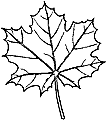 Norway Maple |
| AMUR MAPLE (Acer
ginnala) Shrub or small tree, 15' - 18' tall; round to irregular crown; trunk, often multistemmed, up to 12". Leaves: Opposite, simple, 1½" - 3" long, usually less than one-third as wide, palmately lobed with doubly toothed margins, middle lobe much larger than lateral lobes; dark green; bright red or orange in autumn. Twigs: Yellowish-brown, slightly angled; buds, reddish-brown, small (1/8" long). Fruit: Samara, 1" long, U-shaped pairs with nearly parallel wings, mature in autumn. Bark: Grayish-brown, smooth; becoming vertically striped. Range: Introduced from China and Japan; hardy to Zone 3a. Remarks: Shade-tolerant; moderate growth rate; moderately long-lived. Attractive ornamental that requires a well-drained soil. Commonly planted in above-ground containers. |
 Amur Maple |
| Beginner's Guide Available Casual nature observers and elementary and secondary school-age youth may prefer the inexpensive, 20-page A Beginner's Guide to Minnesota Trees. It identifies the 35 tree species commonly found in Minnesota with easy-to-follow keying symbols. Call the MES Distribution Center at (800) 876-8636 or (612) 625-8173 for price and availability. Ask for item BU-6593-GO. |